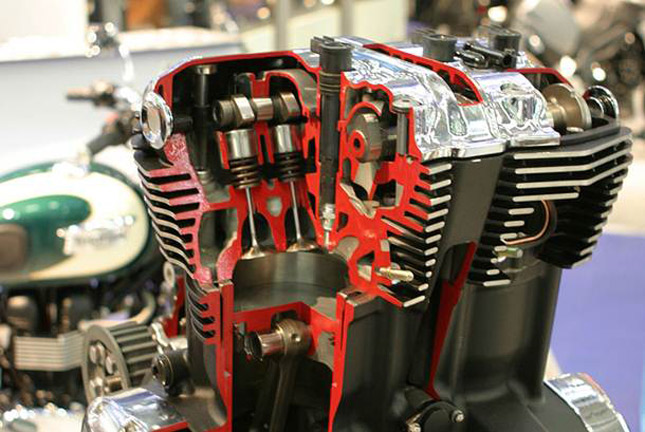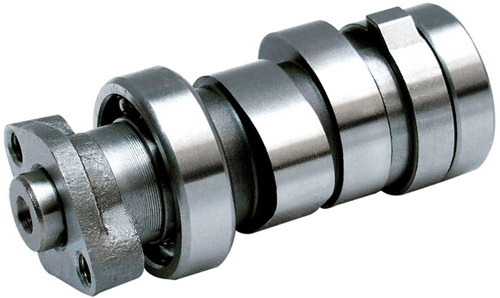 Check out the specs of any bike, you will notice something in there that reads SOHC or DOHC. The full form of this is Single Overhead Camshaft and Double Overhead Camshaft. Now we take this piece of information for granted as it doesn’t really make a difference to us when riding our bikes. But really, it does make a huge difference, because ultimately, the power being generated from the engine has a big influence on the camshaft. So let’s check out what the camshaft really is and how it affects the functioning of our bikes.
Check out the specs of any bike, you will notice something in there that reads SOHC or DOHC. The full form of this is Single Overhead Camshaft and Double Overhead Camshaft. Now we take this piece of information for granted as it doesn’t really make a difference to us when riding our bikes. But really, it does make a huge difference, because ultimately, the power being generated from the engine has a big influence on the camshaft. So let’s check out what the camshaft really is and how it affects the functioning of our bikes.For starters, camshaft is a shaft that is a rod made out of metal or alloys of various materials and has lobes on it designed with certain specifications in mind to suit the running of the bike. The operation of the valves of the engine is dependent on the camshaft and its lobes as they are the one controlling the opening and closing of the valves along with the timing of it. The camshaft is the one rotating along with the crankshaft that is turning the engine, i.e. the piston moving up and down.
 When the camshaft’s lobe presses on the valve, it gets pushed in allowing for the air-fuel mixture to enter the combustion chamber, and the second lobe ensures the exhaust valve opening at the right time for the gases to exit. The timing is very crucial here and hence the specific designing of the camshaft to make sure the valves open and close at the right time for the proper functioning of the valves.
When the camshaft’s lobe presses on the valve, it gets pushed in allowing for the air-fuel mixture to enter the combustion chamber, and the second lobe ensures the exhaust valve opening at the right time for the gases to exit. The timing is very crucial here and hence the specific designing of the camshaft to make sure the valves open and close at the right time for the proper functioning of the valves.The camshaft is generally connected to the crankshaft with the use of a chain or a belt or directly via a gear depending on the design of the engine. The turning of the piston and the working of the valves has to be in tandem and hence the concept of timing is important here. Which is why the camshaft is tuned with the chain in the correct timing and hence the connecting chain is known as the Timing Chain. In some cases, the camshaft also controls the oil pump allowing the oil to circulate throughout the engine efficiently.
Now coming to the SOHC and DOHC combination, the SOHC means the engine employs a single camshaft for both the intake and exhaust valves and is generally the case with single cylinder and parallel twin setups, though they can use multiple camshafts which is the DOHC setup where the exhaust and intake valves are controlled by two separate camshafts. But in the case of V-twin setups of inline 4 setups, many manufacturers employ the DOHC setup to make sure the engine works smoothly and in case one of the camshafts falter, the second one is available to partially run the engine to be moved to the nearest repair center to get it fixed.
READ ALSO: SOHC Vs DOHC Motorcycle Engines
The lobes of the camshaft are designed in such a way so as to open the valve just enough for the certain amount of time to make sure the air-fuel mixture enters and the exhaust gases exit with proper efficiency. Less timing would mean less air-fuel mixture and less power and more means the mixture would be more than required and would result in incomplete combustion. Also the valves play and movement also need to be considered so that the valves do not open and close with a thud or a harsh play. If the valves close with an abrupt movement and not smooth one, they will be damaged sooner resulting in mishaps, which could get fatal for the rider as well as for the bike.
So remember that the camshaft has more importance than it gets credit. Do know that the SOHC and DOHC do not really make much of a difference to the bike, but it always does help depending upon the configuration of the engine. Honda has the knack to opt for a DOHC setup even for some of its singles while many other manufacturers prefer SOHC setup for their parallel or inline configurations. The manufacturer decides the best which suits the engine.
READ ALSO: Engine Tappet Noise- All you need to know
One can be a little experimental and get a custom camshaft to extract a little more power from the bike, but the difference is really negligible and the pains are a lot to get the camshaft designed to the exact specifications needed, and if not it could be a total disaster. It is generally recommended to not fiddle with the camshaft of the motorbike, but in case if you do wish to go for it, get it done from a proper professional or at least from someone who knows what he/she is doing
So now that we know what a camshaft does, have fun with your bike and know its limits when riding. Be safe and take care of yourself as well as others on the road, and stay tuned to BikesIndia for more such informative articles on two wheelers.
By: Pratik Patole











